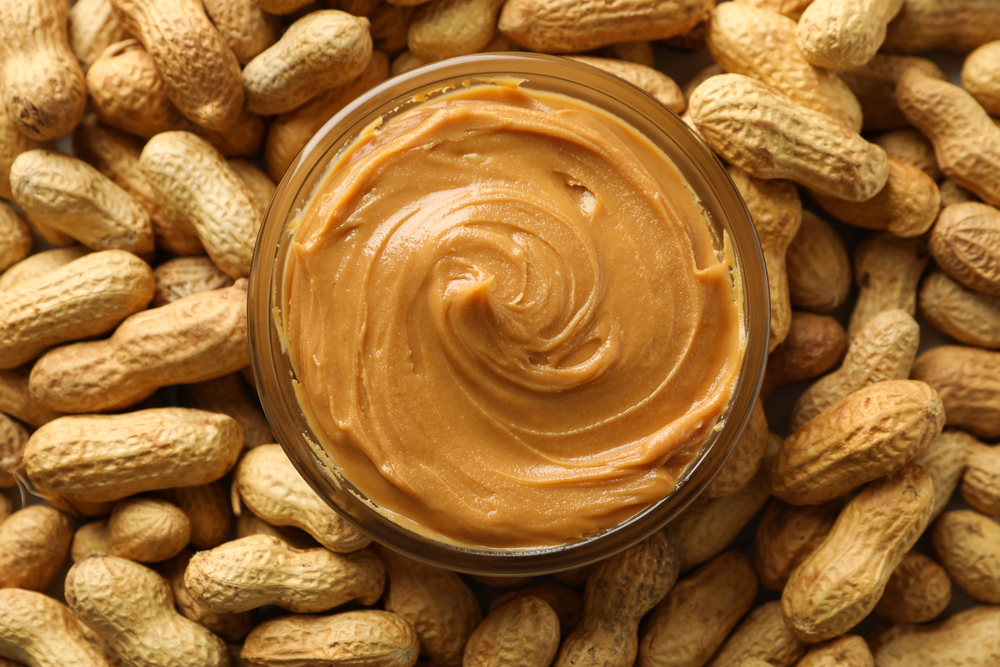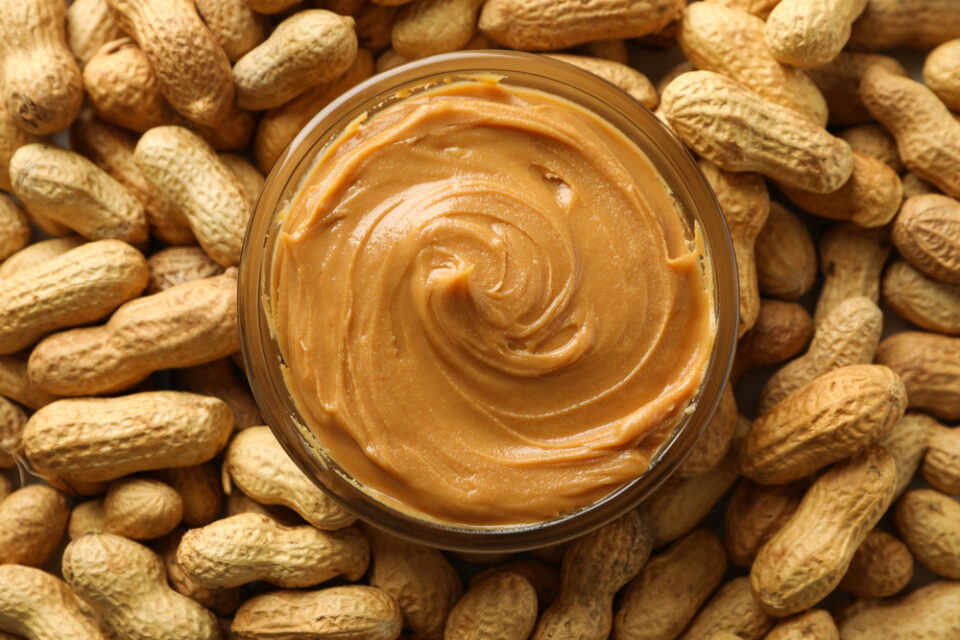By EATING WELL
:max_bytes(150000):strip_icc():format(webp)/deborah-murphy-249e9d92ada04b03a3039ea96ac49291.jpg)
Deborah Murphy is a food and nutrition blogger, recipe developer, content creator and consulting dietitian. She is an expert in plant-based nutrition and has more than 10 years of experience providing medical nutrition therapy for the geriatric population.

Published on April 26, 2024
Reviewed by Dietitian
In This Article
- Health Benefits of Peanut Butter
- Nutritional Profile of Peanut Butter
- Is Peanut Butter Safe to Eat?
- Factors to Consider When Choosing a Peanut Butter
- Frequently Asked Questions
:max_bytes(150000):strip_icc():format(webp)/Is-Peanut-Butter-Healthy-9b0930b6b2ea44f6a080abb390644270.jpg)
Peanut butter is a beloved pantry staple. This popular nutty spread is not only delicious, but adding a tablespoon or two to whole-wheat toast or apple slices is an easy way to add healthy fats and protein to level up a simple snack. So, if you’re a PB-lover, you might be wondering how eating it regularly may impact your health. Read on to learn about the nutrients in peanut butter, how they impact your health and how to enjoy more of it. Grab your spoonful—let’s dig in.
Health Benefits of Peanut Butter
Supports a Healthy Heart
As a plant-based food, peanut butter does not contain any cholesterol. In addition, it supports ticker health due to its favorable fat profile. “Peanut butter is also a good source of heart-healthy monounsaturated fats, which can help lower LDL (harmful) cholesterol and triglyceride levels,” says Wan Na Chun, M.P.H., RD, owner of One Pot Wellness.
One study found that regular peanut intake (including the nuts themselves or a serving of peanut butter made with peanuts and salt only) for six months was able to significantly improve participants’ cholesterol levels.1 Other research has also linked nut and seed consumption with lower risk of heart disease and stroke, possibly because of their ability to help lower blood lipid levels.2 (Peanuts are technically a legume, but they were included in the research.) Just keep in mind that healthier fats should replace some of the saturated fat in your diet to get the most benefits for cholesterol and heart health.
Helps Keep Blood Sugars in Check
“Peanut butter is a great choice for individuals trying to manage their blood sugar. Fat and protein in peanut butter are slowly absorbed and help to keep blood sugar levels more stable”, says Lisa Andrews, M.Ed., RD, a registered dietitian nutritionist and owner of Sound Bites Nutrition.
The positive blood sugar effects of peanut butter appear to apply meal-to-meal as well as over the long term. A small study showed that eating 2 tablespoons of peanut butter with a high-glycemic meal helped stabilize blood sugar.3 (High-glycemic foods are those that can cause a blood sugar spike.) When it comes to the long-term benefits of peanut butter, a review of eight studies found that peanut butter eaters had a 13% lower risk of developing type 2 diabetes than those who rarely consume peanut butter.4
Packed with Antioxidants
When you think of foods high in antioxidants, peanut butter might not be the first to come to mind. However, this nutty spread could give kale a run for its money. “Peanuts provide multiple antioxidants, including vitamin E, coumaric acid, resveratrol and p-coumarin. These may help to protect against heart disease and cancer,” says Andrews. Antioxidants help neutralize damage from disease-causing free radicals, and following an antioxidant-rich eating plan can help protect your body.
May Support Your Goals for Weight Management
Peanut butter contains nearly 200 calories per serving—so can it really fit if your goal is to lose weight? “Peanut butter has gotten a bad rap for being fattening due to higher calories per bite, but this can’t be farther from the truth. This mindset prevents you from embracing the idea that all foods can fit into a healthy diet,” says Marissa Beck, M.S., RDN, founder of REVV Health. In fact, including healthy fats in your diet can play a role in helping you reach your weight-loss goals.
In general, research has found that consuming nuts or peanut butter does not hinder weight loss success, despite them being calorie-dense foods. For example, one study found that when participants on a reduced-calorie diet ate 1 ounce of peanuts before two meals per day, their weight loss was comparable to those on a low-fat diet.5 The combination of protein and fat in peanuts (and peanut butter) promotes satiety, which is why pairing peanut butter with an apple, for instance, can make a much more satisfying snack than the fruit alone.
Nutritional Profile of Peanut Butter
One serving (2 tablespoons) of unsalted smooth peanut butter contains the following:6
- Calories: 191
- Protein: 7 g
- Total Fat: 16 g
- Saturated Fat: 3 g
- Total Carbohydrates: 7 g
- Dietary Fiber: 1.6 g
- Total Sugar: 3 g
- Cholesterol: 0 mg
- Sodium: 5 mg
- Magnesium: 54 mg (13% Daily Value)
- Folate: 28 mcg (7% DV)
- Vitamin E: 3 mg (20% DV)
Is Peanut Butter Safe to Eat?
Peanut Butter Allergy
While consuming peanut butter may promote the benefits above, about 1.8% of the U.S. population has an allergy to peanut butter.7 Peanuts are one of the nine major food allergens.8 If you have an allergy to peanut butter, your immune system mistakenly identifies peanut butter as a threat, which triggers an allergic reaction, the symptoms of which include itching, swelling and hives, digestive problems and anaphylaxis, which can be potentially life-threatening without prompt treatment.
Peanut Butter Food Safety Concerns
Although peanut butter is highly regulated, you may have heard about some food recalls and food safety concerns.9 Peanut butter is susceptible to contamination by Salmonella and aflatoxins.10 Due to its low water content, Salmonella can survive for long periods in peanut butter. However, roasting the peanuts before processing them into peanut butter helps kill off any Salmonella that may be present.
Aflatoxins come from the mold that peanuts come in contact with while growing underground, but strict regulations keep any affected peanuts out of production. As long as you are purchasing peanut butter produced by a large manufacturer, the risk of either of these pathogens in your peanut butter is low. Still, staying up-to-date on the latest food recalls is always a good idea.
Factors to Consider When Choosing a Peanut Butter
The variety of peanut butter options available has grown to the point that it can be confusing to pick the healthiest one. For example, it’s common to see the word “natural” on peanut butter labels, but that doesn’t guarantee it is a healthier choice. According to the Food and Drug Administration, the term “natural” means that nothing synthetic or artificial is in the product, but “natural” peanut butter can still have hydrogenated oils and added sugar, which may not align with your health goals.11
“When selecting a healthy peanut butter, it’s important to choose one that is minimally processed and contains only a few simple ingredients,” says Chun. “The healthiest peanut butters will have just two ingredients: peanuts and a small amount of salt,” she says. If you want to try a flavored peanut butter with little to no added sugar, Chun suggests making your own. Sprinkling in cinnamon or pumpkin spice or adding a small amount of maple syrup are great options for boosting flavor.
The Bottom Line
Peanut butter is a good source of plant-based protein and rich in heart-healthy monounsaturated and polyunsaturated fats. It is also low in carbs, making it a great spread for those with diabetes. In addition to peanut butter’s healthy fat profile, it is also rich in antioxidants like vitamin E, which can be included in a diet for chronic disease prevention. In addition, despite the calorie density of peanut butter, it may actually help you reach your weight-loss goals.
When stocking up on your next jar, experts recommend reaching for a peanut butter with a short ingredient list—ideally just peanuts and a small amount of salt.
